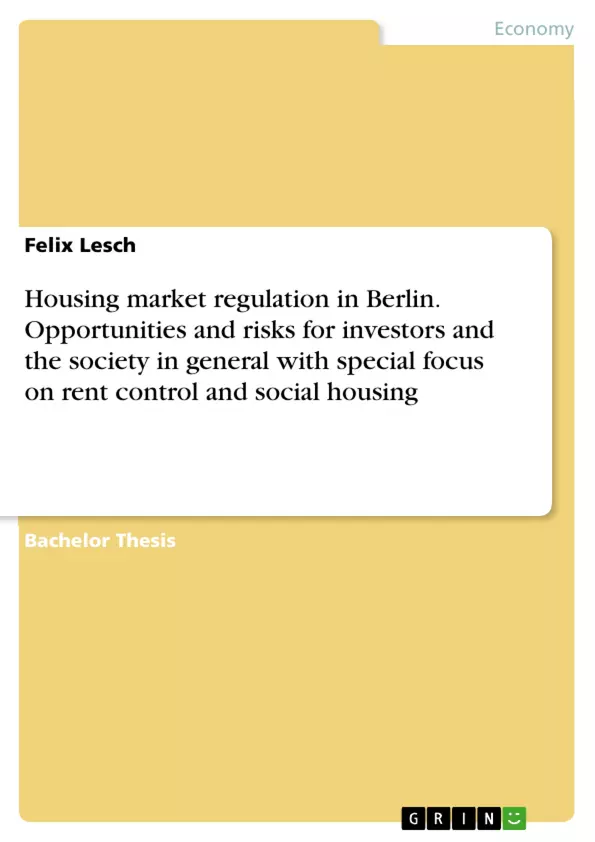This thesis is about the housing market regulation in berlin.
The paper begins with an overview of the current housing market situation in berlin. The development of the demand for housing and the supply of housing is presented and then put into context. The third chapter deals with the berlin rent cap. First, the legal basis is explained before the legal assessment of the rent cover is carried out. In a first step, the formal constitutionality of the law is examined. Then the material constitutionality regarding the compatibility of the rent cap with Art. 14 and 3 GG is analysed. In the following, possible economic effects of the rent cap are presented and supplemented by an overview of empirical data from studies on rent control. The fourth chapter deals with social housing.
As in the second chapter, the current situation in this residential segment in berlin is presented first. Subsequently, social housing is examined as a form of investment. In this context, the reluctance of private investors to invest in affordable housing is discussed and conditions are explained under which construction activity in social housing could be increased in a way that is worthwhile for investors and society. The aim of this work is to examine which interventions in the berlin housing market with the intention of increasing affordable living space are being carried out by the Berlin state government and how these are to be assessed against the background of the resulting opportunities and risks for investors and society as a whole.
Table of Contents
- Introduction
- Problem Definition
- Objectives and Work Structure
- Berlin Housing Market
- Development of Housing Demand
- Development of Population
- Development of Household Structure
- Development of Income
- Development of Housing Supply
- Construction Activity
- Housing Stock
- Development of Rents in Berlin
- Asking Rents
- Expert List of Representative Rents
- Analysis of the Current Situation on the Housing Market
- The Berlin Rent Cap
- Gesetz zur Neuregelung gesetzlicher Vorschriften zur Mietenbegrenzung
- Legal Evaluation of the Rent Cap
- Principles of the Division of Legislative Powers
- Mietrechtsnovellierungsgesetz - MietNovG
- Legal Opinion in Favor of the Rent Cap
- Legal Opinion against the Rent Cap
- Analysis of the Formal Constitutionality
- Analysis of the Material Constitutionality
- Compatibility with Article 14 (1) GG
- Scope, Protection and Encroachment on the Fundamental Right
- Constitutional Justification
- Legitimate Purpose and Suitability
- Necessity
- Proportionality in the Narrower Sense
- Rent Freeze
- Modernization Measures
- Rent Ceilings
- Equal and Unequal Treatment - Proportionality Test within the Framework of Article 3 (1) GG
- Effects of the Rent Cap on Society and Investors
- Possible Economic Effects of the Berlin Rent Cap
- Housing Demand
- Moving Behavior and Mismatching in the Housing Market
- Sale of Apartments to Owner-Occupiers
- Investments in New Construction
- Investments in the Existing Housing Stock
- Empirical Evidence from Other Countries
- Rent Control in San Francisco
- Removal of Rent Control in Norway
- Social Housing
- Social Housing in Germany
- Social Housing in Berlin
- Households Eligible to Public Housing
- Funding Modalities
- Development of Social Housing Stock
- New Construction Subsidies for Social Rental Housing
- Social Housing as an Investment
- Investment Reluctance of Private Investors
- Building Costs
- Microeconomic Restrictions
- Private Housing Companies Engaging in Social Housing Construction
- Incentives Set for Investments in Social Housing
- Neue Wohnungsgemeinnützigkeit
Objectives and Key Themes
This Bachelor thesis examines the regulation of the housing market in Berlin, focusing on the opportunities and risks for investors and society in general. It aims to analyze the effects of the rent cap and social housing policies on the housing market, considering both legal and economic perspectives.
- The impact of the Berlin rent cap on the housing market, including legal and economic considerations.
- The role and effectiveness of social housing in addressing affordability issues in Berlin.
- The potential consequences of rent control on investors, both private and institutional.
- The legal framework and constitutionality of rent control in Germany.
- An overview of the housing market dynamics in Berlin, including supply, demand, and rent trends.
Chapter Summaries
- Introduction: This chapter introduces the topic of housing market regulation in Berlin, outlining the problem of affordability and the objectives of the thesis.
- Berlin Housing Market: This chapter provides an overview of the Berlin housing market, analyzing the developments in housing demand, including population growth, household structure, and income, as well as the developments in housing supply, including construction activity, the housing stock, and rent trends.
- The Berlin Rent Cap: This chapter delves into the legal framework and the effects of the Berlin rent cap on the housing market. It examines the legal evaluation of the rent cap, including the principles of the division of legislative powers and the constitutionality of the regulation. It also analyzes the potential economic effects of the rent cap, exploring factors like housing demand, moving behavior, and investment patterns.
- Social Housing: This chapter focuses on social housing as a tool for addressing affordability in Berlin. It outlines the legal framework for social housing in Germany and analyzes the specific situation in Berlin, including household eligibility, funding modalities, and the development of the social housing stock. It also examines the challenges of attracting private investment in social housing.
Keywords
The main keywords and focus topics of the thesis are housing market regulation, rent control, social housing, Berlin, Germany, investment, affordability, legal evaluation, economic impact, housing demand, housing supply, construction activity, population growth, household structure, income development, rent trends.
- Citar trabajo
- Felix Lesch (Autor), 2021, Housing market regulation in Berlin. Opportunities and risks for investors and the society in general with special focus on rent control and social housing, Múnich, GRIN Verlag, https://www.grin.com/document/1011806



